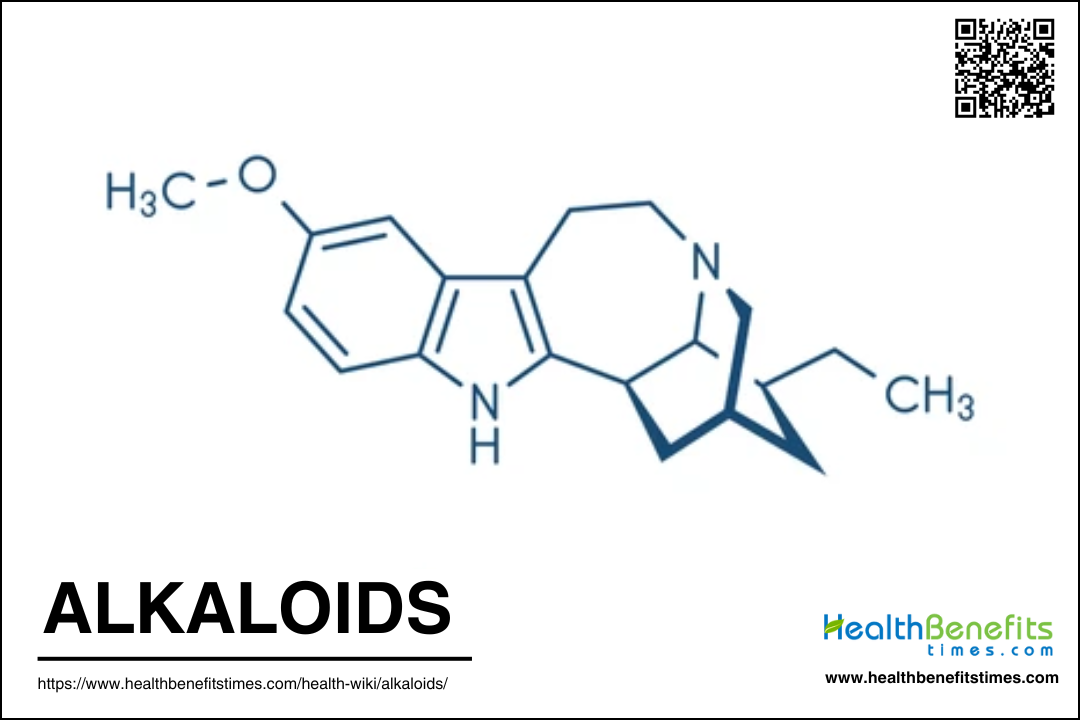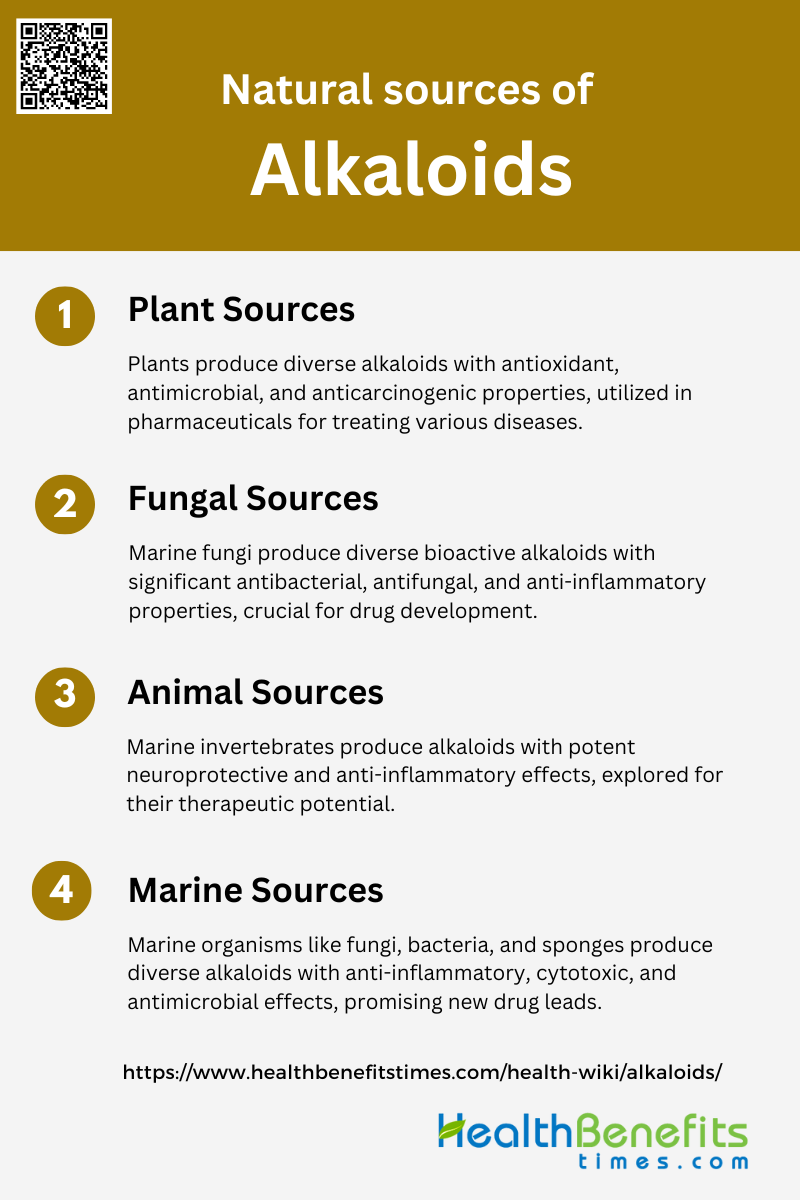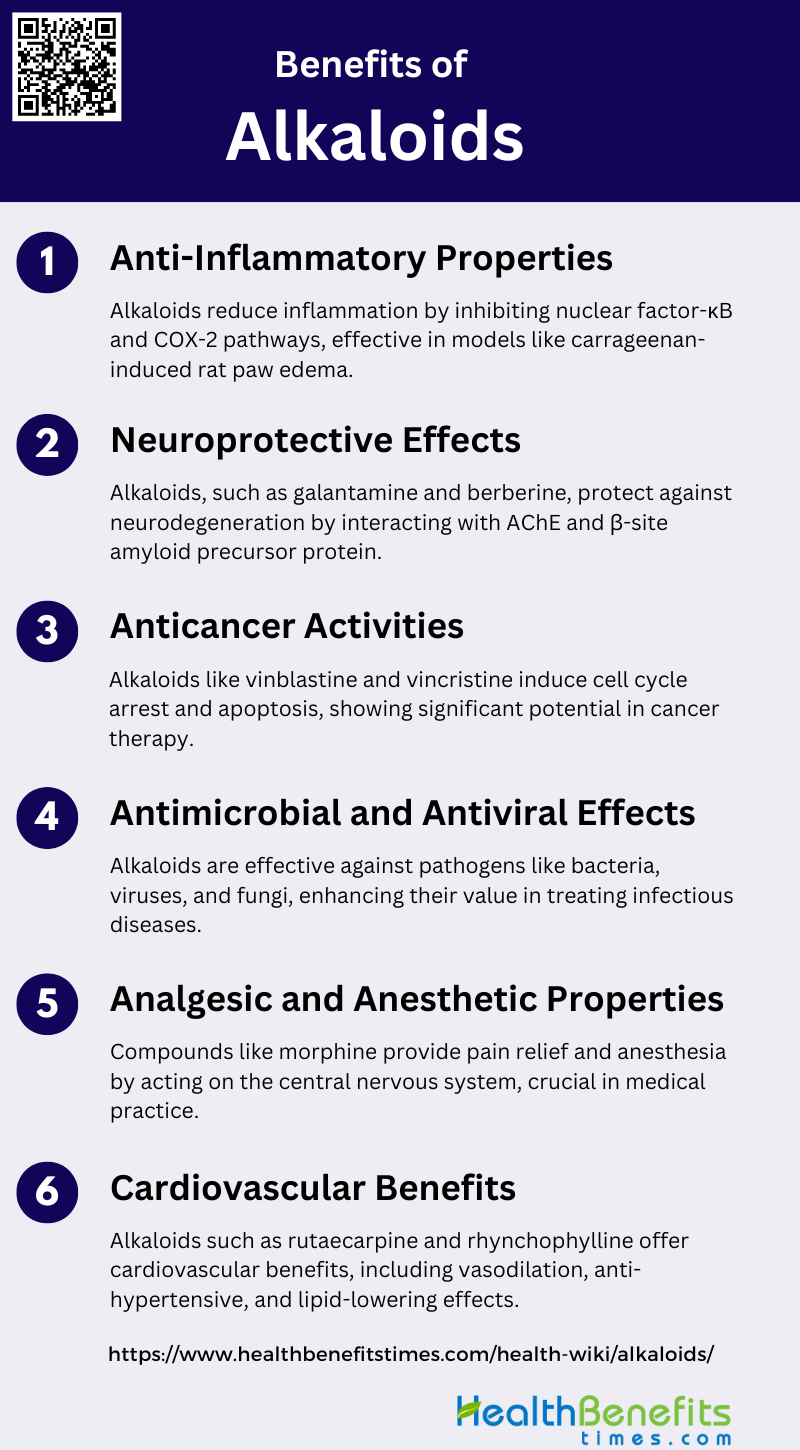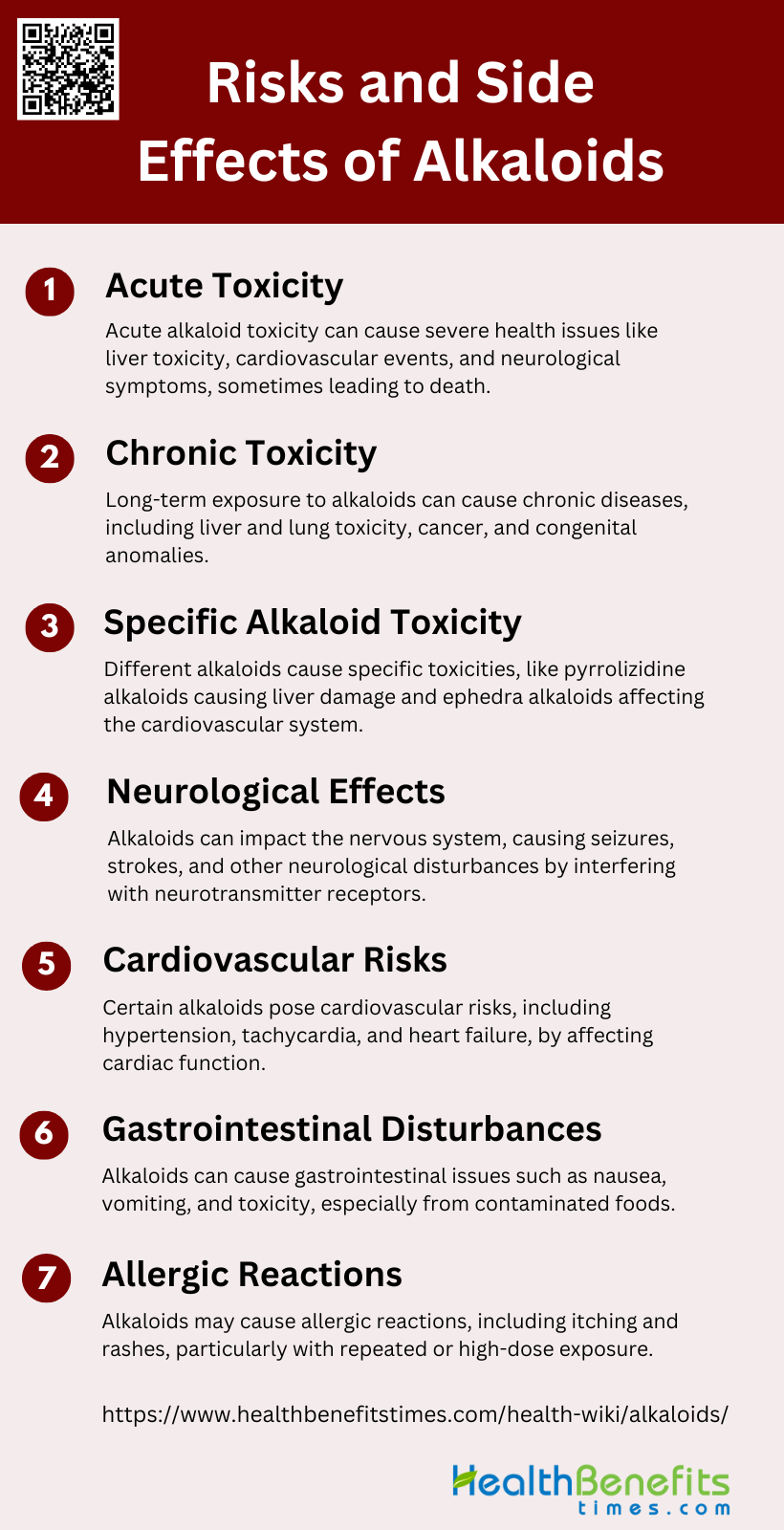Alkaloids are a diverse group of naturally occurring organic compounds that predominantly contain basic nitrogen atoms. These compounds are primarily found in plants and are known for their significant pharmacological effects on humans and animals. Alkaloids have been used for centuries in traditional medicine and continue to be a crucial source of therapeutic agents. They exhibit a wide range of biological activities, including analgesic, antimalarial, antibacterial, and anticancer properties. Some well-known alkaloids include morphine, quinine, strychnine, and caffeine. The structural diversity of alkaloids allows them to interact with various biological targets, making them valuable in drug discovery and development.
Natural sources of Alkaloids
Alkaloids are naturally occurring compounds found in a variety of plants, animals, and microorganisms. These compounds often have potent pharmacological effects and have been used for centuries in traditional medicine. The following is a list of natural sources where alkaloids can be found:
1. Plant Sources
Plants are a prolific source of alkaloids, which are secondary metabolites with significant pharmacological activities. These compounds are known for their antioxidant, antimutagenic, anticarcinogenic, and antimicrobial properties, making them valuable in the treatment of various diseases. Alkaloids such as berberine, found in the roots and stem-bark of Berberis asculin P. Renault, are utilized for their ability to kill a variety of microorganisms. The diversity of alkaloids in plants includes classes like pyrrolizidines, quinolizidines, indoles, and isoquinolines, each with unique bioactive properties that pharmaceutical companies harness for drug development.
2. Fungal Sources
Fungi, particularly marine-derived species, are another rich source of bioactive alkaloids. Marine fungi like those from the genus Penicillium have been extensively studied for their ability to produce a wide array of alkaloids with diverse biological activities. These alkaloids exhibit significant cytotoxic, antibacterial, antifungal, antiviral, and antioxidant properties, making them promising candidates for drug development. For instance, the marine-derived fungus Aspergillus sclerotiorum has yielded new alkaloids such as sclerotioloids, which show potential anti-inflammatory activity. The structural diversity and biological activities of these fungal alkaloids underscore their importance in pharmaceutical research.
3. Animal Sources
Alkaloids are also found in various animal species, although this source is less common compared to plants and fungi. Certain marine invertebrates, such as sponges and ascidians, produce alkaloids that have evolved as defense mechanisms against predators. These compounds often exhibit potent biological activities, including neuroprotective and anti-inflammatory effects. For example, marine indole alkaloids, which resemble endogenous amines like serotonin and dopamine, have shown potential in treating neurological disorders such as depression and anxiety. The unique properties of animal-derived alkaloids continue to be explored for their therapeutic potential.
4. Marine Sources
The marine environment is a treasure trove of bioactive alkaloids, with marine organisms such as fungi, bacteria, sponges, and seaweed being prolific producers. Marine-derived alkaloids are known for their structural diversity and potent biological activities, including anti-inflammatory, cytotoxic, and antimicrobial effects. For instance, marine fungi have been identified as a valuable reservoir of alkaloids, with numerous compounds showing significant pharmacological activities. Additionally, marine indole alkaloids have been investigated for their potential in treating neurological disorders, highlighting the vast therapeutic potential of marine-derived alkaloids. The continuous exploration of marine sources promises to yield new and effective drug leads.
Types of Alkaloids
Alkaloids are a diverse group of naturally occurring compounds that contain nitrogen atoms. They are classified based on their chemical structure and biological activity. Below is a list of different types of alkaloids:
1. True Alkaloids (Heterocyclic Alkaloids)
True alkaloids are nitrogen-containing compounds that have a nitrogen atom within a heterocyclic ring. These compounds are typically derived from amino acids and are known for their potent biological activities. True alkaloids are found in a variety of plants and have significant pharmacological effects, often used in medicine for their therapeutic properties. Examples of true alkaloids include morphine, which is used as a powerful analgesic, and nicotine, which is found in tobacco plants and has stimulant properties.
2. Protoalkaloids (Non-Heterocyclic Alkaloids)
Protoalkaloids are a class of alkaloids that contain nitrogen but do not have the nitrogen atom within a heterocyclic ring. These compounds are also derived from amino acids and exhibit various biological activities. Protoalkaloids are less common than true alkaloids but still play important roles in plant defense and human medicine. Examples of protoalkaloids include ephedrine, which is used as a decongestant and bronchodilator, and mescaline, a psychoactive compound found in certain cacti.
3. Pseudoalkaloids
Pseudoalkaloids are nitrogen-containing compounds that are not derived from amino acids and do not have a nitrogen atom within a heterocyclic ring. These compounds are often derived from terpenes or steroids and exhibit a wide range of biological activities. Pseudoalkaloids are found in various plants and are used in medicine for their therapeutic effects. Examples of pseudoalkaloids include caffeine, a stimulant found in coffee and tea, and solanine, a toxic compound found in nightshade plants.
Benefits of Alkaloids
Alkaloids are naturally occurring compounds that offer a range of health benefits. They are known for their therapeutic properties, including pain relief, anti-inflammatory effects, and antimicrobial activity. Below is a list of the benefits of alkaloids:
1. Anti-Inflammatory Properties
Alkaloids exhibit significant anti-inflammatory properties, which have been extensively studied and documented. Diterpenoid alkaloids, for instance, have shown promising results in reducing inflammation through mechanisms such as the inhibition of nuclear factor-κB and cyclooxygenase-2 (COX-2) pathways. These compounds have been tested in various models, including carrageenan-induced rat paw edema, demonstrating their efficacy in reducing inflammation. Additionally, isoquinoline alkaloids have been identified as potent anti-inflammatory agents, further supporting the therapeutic potential of alkaloids in managing inflammatory conditions.
2. Neuroprotective Effects
Alkaloids also possess neuroprotective effects, making them potential candidates for treating neurodegenerative diseases. Compounds such as galantamine and berberine have been shown to interact with acetylcholinesterase (AChE) and β-site amyloid precursor protein, which are crucial in the pathology of neurodegenerative disorders. Rhynchophylline, an indole alkaloid, has demonstrated protective effects on the central nervous system by modulating calcium and potassium channels, thereby preventing neurodegeneration. These findings highlight the potential of alkaloids in developing novel therapeutic strategies for neuroprotection.
3. Anticancer Activities
Alkaloids have been widely recognized for their anticancer activities. Several alkaloids, including vinblastine, vinorelbine, and vincristine, have been successfully developed into anticancer drugs. These compounds induce cell cycle arrest, apoptosis, and autophagy, leading to cancer cell death. The molecular mechanisms underlying these effects involve binding to nucleic acids or proteins, enzyme inhibition, and epigenetic modulation. The broad spectrum of anticancer activities exhibited by alkaloids underscores their importance in cancer therapy and drug development.
4. Antimicrobial and Antiviral Effects
Alkaloids have demonstrated significant antimicrobial and antiviral effects, making them valuable in treating infectious diseases. These compounds have been effective against a range of pathogens, including bacteria, viruses, and fungi. For instance, alkaloids from medicinal plants have shown activity against influenza, HIV, herpes simplex virus, and hepatitis. The ability of alkaloids to modulate inflammatory responses further enhances their therapeutic potential in managing infections and associated inflammation.
5. Analgesic and Anesthetic Properties
The analgesic and anesthetic properties of alkaloids have been well-documented, with compounds like morphine and codeine being widely used for pain relief. These alkaloids act on the central nervous system to alleviate pain and provide anesthesia, making them crucial in medical practice. The diverse pharmacological activities of alkaloids, including their role as muscle relaxants and painkillers, highlight their importance in pain management and anesthesia.
6. Cardiovascular Benefits
Alkaloids also offer cardiovascular benefits, with several compounds showing protective effects on the cardiovascular system. Rutaecarpine, for example, has been found to possess vasodilatory, anti-platelet activation, and lipid-lowering effects, making it beneficial in treating cardiovascular diseases. Rhynchophylline has demonstrated anti-hypertensive and anti-arrhythmic properties, further supporting the cardiovascular benefits of alkaloids. These findings suggest that alkaloids could be valuable in developing treatments for various cardiovascular conditions.
Risks and Side Effects of alkaloids
While alkaloids have numerous therapeutic benefits, they also come with potential risks and side effects. These compounds can be toxic in high doses and may cause adverse reactions in some individuals. Below is a list of the risks and side effects associated with alkaloids:
1. Acute Toxicity
Acute toxicity of alkaloids can manifest rapidly following exposure, often leading to severe health consequences. Pyrrolizidine alkaloids (PAs) are particularly notorious for causing acute liver toxicity, specifically hepatic veno-occlusive disease (HVOD), following ingestion of PA-containing herbs or contaminated foods. Additionally, dietary supplements containing ephedra alkaloids have been linked to acute cardiovascular and central nervous system events, including hypertension, palpitations, stroke, and seizures, with some cases resulting in death or permanent disability. The acute toxicity of protopine total alkaloids from Macleaya cordata has also been documented, with an LD50 of 481.99 mg/kg in mice, indicating significant toxicity at higher doses.
2. Chronic Toxicity
Chronic exposure to alkaloids can lead to long-term health issues, often due to their bioaccumulation and persistent effects on various organs. Pyrrolizidine alkaloids, for instance, are genotoxic and can cause chronic diseases such as pulmonary arterial hypertension, cancers, cirrhosis, and congenital anomalies. Long-term consumption of foods contaminated with PAs, such as herbal teas, poses a significant health risk, potentially leading to chronic liver and lung toxicity. Chronic toxicity studies on protopine total alkaloids have shown no reproductive or embryonic developmental toxicity at certain doses, but further investigation is needed to fully understand their long-term effects.
3. Specific Alkaloid Toxicity
Different alkaloids exhibit specific toxicities based on their chemical structure and mode of action. Pyrrolizidine alkaloids are primarily hepatotoxic, causing liver damage and HVOD. Ephedra alkaloids are associated with cardiovascular and central nervous system toxicity, leading to hypertension, palpitations, and neurological events. Veratrum alkaloids, such as isorubijervine and rubijervine, exhibit strong cardiovascular toxicity by blocking cardiac sodium channels, particularly NaV1.5, which is crucial for cardiac function. These specific toxicities highlight the diverse and potentially severe effects of different alkaloids.
4. Neurological Effects
Alkaloids can significantly impact the nervous system, often due to their structural similarity to neurotransmitters. Many alkaloids interfere with neurotransmitter receptors or ion channels, modulating neuronal signal transduction. Ephedra alkaloids, for example, have been linked to central nervous system events such as seizures and strokes. Quinolizidine, β-carboline, and ergot alkaloids are known neurotoxins that can cause various neurological disturbances without requiring bioactivation. These effects underscore the potential for alkaloids to disrupt normal neurological function and cause severe neurological symptoms.
5. Cardiovascular Risks
Cardiovascular toxicity is a significant risk associated with certain alkaloids. Ephedra alkaloids have been implicated in numerous cardiovascular events, including hypertension, tachycardia, and even death. Veratrum alkaloids exert their cardiovascular toxicity by inhibiting cardiac sodium channels, particularly NaV1.5, leading to severe adverse effects on cardiac function. Additionally, pyrrolizidine alkaloids can cause pulmonary hypertension and heart failure, further highlighting the cardiovascular risks posed by these compounds. These findings emphasize the need for caution when consuming alkaloid-containing products.
6. Gastrointestinal Disturbances
Alkaloids can cause various gastrointestinal disturbances, ranging from mild to severe. Common symptoms include nausea, vomiting, and mild gastrointestinal perturbation. Some alkaloids, such as those found in Veratrum species, are used to treat gastrointestinal issues but can also induce serious side effects, including gastrointestinal toxicity. The ingestion of PA-contaminated foods can lead to gastrointestinal symptoms as part of their broader toxic effects. These disturbances highlight the potential for alkaloids to adversely affect the gastrointestinal system.
7. Allergic Reactions
Allergic reactions to alkaloids, while less commonly reported, can still occur and pose significant health risks. The immune system may react to certain alkaloids, leading to symptoms such as itching, rashes, and other allergic manifestations. Although specific studies on allergic reactions to alkaloids are limited, the potential for such reactions exists, particularly with repeated or high-dose exposure. Further research is needed to fully understand the immunogenic potential of various alkaloids and their role in allergic responses.
Examples of Well-Known Alkaloids
Alkaloids are a class of naturally occurring organic compounds that have significant pharmacological effects. Many well-known alkaloids are used in medicine and have been studied extensively for their therapeutic properties. Below is a list of examples of well-known alkaloids:
1. Caffeine
Caffeine is a well-known alkaloid predominantly found in coffee, tea, and guarana. It is also present in cocoa nuts, which contain theobromine, a compound similar to caffeine. As a stimulant, caffeine acts on the central nervous system to increase alertness and reduce fatigue. It achieves this by blocking adenosine receptors, which normally promote sleep and relaxation. Regular consumption of caffeine can lead to increased tolerance and dependence, but moderate intake is generally considered safe for most people. However, excessive consumption can result in negative effects such as insomnia, jitteriness, and increased heart rate.
2. Nicotine
Nicotine is an alkaloid found primarily in tobacco plants, and it is the main addictive component of tobacco products. It acts on nicotinic acetylcholine receptors in the brain, leading to the release of neurotransmitters such as dopamine, which contributes to its addictive properties. Nicotine addiction is a major public health concern due to its association with smoking-related diseases, including lung cancer, cardiovascular disease, and chronic obstructive pulmonary disease (COPD). Additionally, minor tobacco alkaloids like nornicotine and anabasine can enhance nicotine’s addictive effects, further complicating efforts to quit smoking.
3. Morphine
Morphine is a potent analgesic derived from the opium poppy (Papaver somniferum) and is widely used in clinical settings to manage severe pain. It works by binding to opioid receptors in the brain and spinal cord, altering the perception of pain and producing euphoria. Despite its effectiveness in pain management, morphine has a high potential for addiction and abuse due to its euphoric effects. Long-term use can lead to tolerance, physical dependence, and withdrawal symptoms upon cessation. Therefore, its use is carefully regulated and monitored in medical practice to minimize the risk of addiction.





